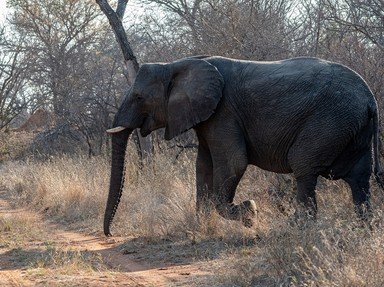Quiz Answer Key and Fun Facts
1. After almost two years since his mother conceived, Elewa the savannah elephant is born, into the mud, blind, and surrounded by a herd of giants. For the next few years, Elewa will be the centre of attention in the herd, being cared for not only by his own mother, but by several other adult female elephants. What name is given to this non-maternal infant care?
2. Although Elewa the savannah elephant is amongst one of the most intelligent species on earth, he is rather helpless to begin with and has to rely on the strong link between himself and his mother. In order to aid his digestion in future, Elewa has to acquire essential gut microflora. How will a young elephant usually acquire this microflora?
3. The first thing that will strike you about Elewa the savannah elephant is his trunk, which is incredibly versatile, as well as visually spectacular. What use of the trunk is aided by *both* the alinasal cartilage and the sensitivity of this elongated organ?
4. As Elewa reaches the age of three, he is now drinking less of his mother's milk, and is eating more vegetation. As a herbivore, Elewa's teeth are highly adapted to grinding all sorts of plant matter, as shown by his large, flat molars. Which type of tooth has evolved over time in elephants to grow to enormous lengths and protrude out, either side of their trunks, as tusks?
5. As mentioned previously, Elewa (who is now 7 years old) is a savannah elephant, and so differs from an Asian elephant in many ways. Which of these is *not* a way in which African (both savannah and forest) elephants differ from Asian elephants?
6. Just as Elewa the savannah elephant turns 13, and reaches puberty, he is coldly forced out of the herd which had cared for him since his birth. Which of these is the most accurate description of Elewa's social relations over the next few decades?
7. Now into his 20s, Elewa the savannah elephant seems to have changed in character from the loveable creature we once knew. His temporal glands have swollen, he releases a constant trickle of urine, and he has become incredibly aggressive. He is in musth. The word "musth" is derived from a Hindi term, meaning what?
8. As Elewa continues to grow, so does his impressive brain, which, it is rumoured, allows him the luxury of "never forgetting". Which of these facts about an elephant's brain is true?
9. Now one of the largest land animals walking the earth, Elewa the savannah elephant requires massive amounts of food and will travel long distances each day to acquire it. Although usually seen as quite slow and lumbering animals, elephants can and will travel rapidly over some parts of their daily journey. What is this behaviour known as?
10. After being born, loved, cast out, hungry, angry, and eventually fathering a son, Elewa the savannah elephant lays down to die, at the ripe old age of 68. It is perhaps worth noting here how emotionally complex elephants are, as demonstrated when faced with death. Which of these is *not* a likely response by elephants who may find Elewa's remains?
Source: Author
doublemm
This quiz was reviewed by FunTrivia editor
crisw before going online.
Any errors found in FunTrivia content are routinely corrected through our feedback system.

